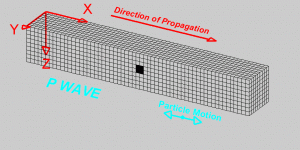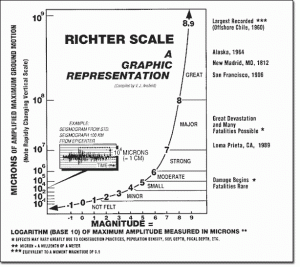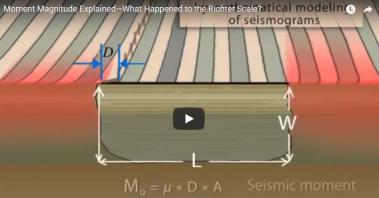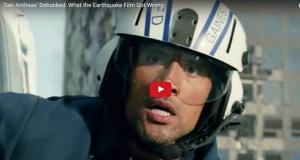Seismic Waves
Section 1: Understanding Seismic Waves
Daily Dose of Destruction: 0-5:30
Seismic waves are vibrations caused by an earthquake. As mentioned in the section on earthquake faults, stress builds up inside the Earth. When that stress is released we get an earthquake. The location at which the stress is built up and then released is called the focus. Seismic waves travel from the focus outwards in all directions. The point on the surface of the Earth at which a seismic wave first hits is called the epicenter. The epicenter is directly above the focus. There are instruments throughout the world that detect earthquakes called seismometers and seismographs.
Seismologists are scientists who study earthquakes. Understanding how seismic waves travel, the speeds at which they travel, and how they move through specific material within the Earth can help scientists locate the epicenters and depths of earthquakes. Below is a video on how seismologists use seismometers and read their corresponding seismograms.
There are a few earthquake waves that we need to understand. The first earthquake waves to hit seismographs, because they are moving the quickest, are called primary waves or p-waves for short. P-waves cause the ground to move back and forth in the same direction. P-waves compress and stretch the rock. Below is an animation of how p-waves travel through the Earth's crust.
The next type of waves to hit seismometers are called secondary waves or s-waves. Particles in an s-wave move at right angles to the direction of the wave's movement. The move is similar to a slinky being shaken in an up-and-down motion. Below you can see how S-waves move.
The last type of earthquake wave to hit seismic stations is the surface wave. Surface waves move back and forth in a swaying motion in all directions. These earthquake waves tend to be the most destructive because one part of a building moves up, while another part might be moving down, left or right. These waves also move along the surface of the earth. There are two types of surface waves: Love Waves and Rayleigh Waves. Below are the animations of both types.
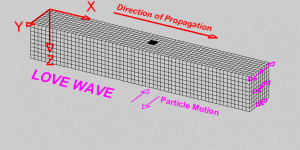
|
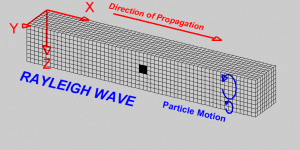
|
The farther apart earthquake waves are on a seismograph, the further the epicenter is from the seismic station. The farther the epicenter is away, the more time a p-wave has of putting distance between itself and an s-wave. To locate an epicenter, seismologists use a method called triangulation. Triangulation uses data from at least three different seismic stations to determine an epicenter's location. Scientists need data from a minimum of three seismographs. However, the more seismic readings scientists get, the easier it is to pinpoint the exact location. Triangulation is used in more than just seismology. GPS works similarly and understanding triangulation helps law enforcement locate criminals with cell phones.
Seismic waves can also help us understand what the inside of the Earth looks like. What is down there and how do we know? The layers of the Earth have different densities. Seismic waves travel at different rates of speed based on a material's density. Hopefully, you understand that the Earth has three main layers: the crust, mantle, and core. Earthquake waves move faster through solids. S-waves can't move through liquids at all, so an area in which S-waves quit moving is considered to be liquid "ish". Both p and s waves slow down when they hit a specific layer called the asthenosphere. The asthenosphere is a plastic-like layer and is part of the upper mantle. Both p and s waves speed up when they hit the solid lower mantle. On the other side of the Earth from where an earthquake hits, there is a place called the shadow zone. This is an area of about 35 degrees where seismic waves are not felt. Why? because the p-waves are deflected and slowed by the liquid outer core and the S-waves stop altogether when they hit the outer liquid core.
The last thing that needs to be mentioned when talking about seismic waves is the scales by which we measure their strength and intensity. The Richter scale is used for small earthquakes and the moment magnitude scale is used for larger earthquakes. They both measure intensity but measure it more accurately for smaller or larger earthquakes respectively.
Richter Scale
Magnitude is a measurement of the amplitude of seismic waves produced by an earthquake. As an earthquake is happening it is shaking seismometers. Seismograms print off pictures that look like waves. The height or amplitude of these recorded waves helps determine the magnitude of an earthquake. Every factor of 10 in the height of the wave corresponds to about 32 times the amount of energy that is released in an earthquake. So for every 10 times, the amplitude of a wave on a seismometer the energy that is released is 32 times greater. Let's compare a 1.0 to a 2.0 on a seismometer. A 2.0 will be 10 times higher on the seismometer which means that a 2.0 earthquake released 32 times more energy. A 3.0 on a scale would have a 10x10 or 100 times larger amplitude than a 1.0 and would release 32x32 or 1024 more energy By the time you get to a 10.0 earthquake the numbers are both very, very large.
Moment Magnitude Scale
This scale takes a few other things into consideration. You calculate the seismic moment by understanding how rigid the Earth around a fault is and multiply it by the average amount that the fault shifted.
The video below will discuss the difference between moment magnitude and the Richter Scale as well as the energy and power during an earthquake.
Even though most earthquakes are measured by the Moment Magnitude Scale most of the time the media reports magnitudes by talking about the Richter Scale.
Go to the following link to compare the differences between moment magnitude and the Richter scale. http://earthalabama.com/energy.html Change the Earthquake Magnitude to see how it compares the two scales. You should notice that both scales show similar numbers until you reach a 5.0 magnitude. After 5.0 the moment magnitude scale really takes off. This is why they have switched to moment magnitude for the larger quakes. It is more accurate.
This next activity will review and take you further in your understanding of measuring and locating earthquakes.
If you are a student at Snowflake, Holbrook or Heber click SUSD5 Student version of the Understanding Earthquakes through Analyzing and Plotting Data.
Purchase this Understanding Earthquakes through Analyzing and Plotting Data activity at Teachers Pay Teachers for $1.25.
Section 2: Current Earthquakes
Daily Dose of Destruction
Below is a video that shows the process of liquefaction. When an earthquake starts compressing and stretching the ground, it squeezes water out of the soil. This can be very dangerous because it can loosen the soil around the foundations of buildings. The video below demonstrates the liquefaction that happened during the 2011 Japan earthquake. If you watch carefully you can see the ground actually shifting and faulting.
Now that you understand what an earthquake is and how it is measured, let's take a look at current earthquakes that are happening around the world.
If you are a student at Snowflake, Holbrook or Heber click SUSD5 student version of the Current USGS Significant Worldwide Earthquake Investigation activity.
Before we move on in our journey to understand the Earth, have you ever wondered what scientists have to say about the portrayal of earthquakes in the movies? Below is a quick video of scientists discussing the movie San Andreas.
Just for fun, here is a sped-up and edited version of the movie San Andreas. I took most of the cheesy dialogue as well as any bad language out and just show the destruction.












